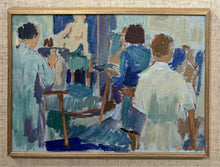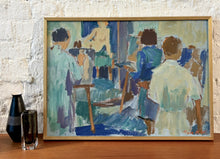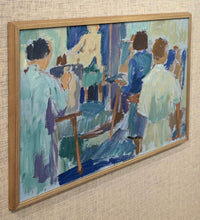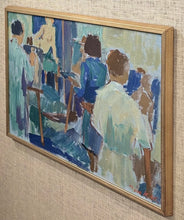
artist: Figge Holmgren (Swedish 1875-1969)
medium: oil on board
dimensions: 71 x 51 cm board size / 74 x 54 cm framed size (approx)
signed and dated 46
AU $1195 (approx US $775 / 665 EUROS / 117,000 yen / 580 GBP - for exact current conversion visit xe.com)
artist biography
Carl Fredrik “Figge” Holmgren was born on September 16, 1875, in Lund, Sweden. He was a Swedish painter, printmaker, and illustrator.
Holmgren studied at the Technical School in Malmö from 1891 to 1896, where he trained as a lithographer. He worked for Skånska Litograf A.B. between 1898 and 1907, and later as a lithographic draftsman at Dansk Reproduktionsanstalt in Copenhagen. He continued his studies at the Royal Danish Academy of Fine Arts’ Free School under Johan Rohde (1910–1912).
Holmgren lived in Denmark from 1904 to 1932 and undertook several study trips: to Paris in 1921, Dresden in 1922, Italy in 1952, and France and Spain in 1953. His artistic style was shaped by both Scandinavian colorism and broader European influences.
He exhibited regularly from 1915 onward, including solo shows in Copenhagen with Emil Pethson and Bror Forssell. He debuted in Sweden at Malmö Art Gallery in 1918. Holmgren also participated in exhibitions organized by the Skåne Artists’ Association, of which he was a founding member.
He held solo exhibitions at Malmö Town Hall (1920, together with E. Pehrson and B. Forssell), the Blackfriars Monastery (Kronhuset) in Lund (1928, 1948, 1955), Malmö Museum (1935), SDS Hall in Malmö (1943 and 1951), Killbergs Art Gallery in Hälsingborg (1950), and Landskrona Museum (1950). He also exhibited with the Swedish-Danish group “The Colourists” (1932–1934) and with “Skåne Artists” at Liljevalchs Konsthall in Stockholm (1951).
Holmgren’s work includes landscapes, still lifes, figure compositions, and portraits in oil, tempera, pastel, and watercolour. He began his career as a professional lithographer and later worked in etching and mezzotint.
His early paintings were characterised by a subdued tonal range, influenced by J.F. Willumsen and J. Paulsen’s colouristic tradition (Interior, 1913, Lund University Art Museum). Later, his palette brightened, often using strong complementary contrasts.
During the 1920s, Holmgren created figural compositions on mythological and religious themes with rhythmic, mosaic-like colour structures (The Family, Europe and the Bull, both 1928). His landscape paintings from this period display a romantic sensibility and vibrant colour harmonies (Fyledalen, 1929). From the 1930s onward, he focused on expressive landscapes, city views, and everyday scenes from Skåne, painted in a textured, impasto style.
Holmgren’s work is held in the collections of the Moderna Museet in Stockholm, the Malmö Museum, Lund University Art Museum, and the public collections of Tomelilla and Borås. He was a member and founder of the artist association Aura in Malmö, and the Danish association Koloristerna.
He passed away at the age of 93 on January 2, 1969 in Helsingborg.







